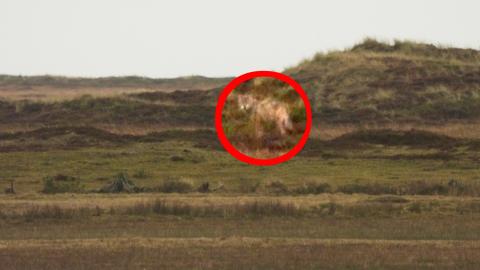Ulv, ulv! Posted by Bjørn A. Bojesen on Oct 18, 2012 in Uncategorized
To many people, Denmark outside of Copenhagen is either a pretty blomsterhave (flower garden) or a boring motorvej (motorway, freeway) that unnecessarily prolongs the drive between Central Europe and the attractive wilderness of Norway and Sweden. Too bad that these people don’t know that there are some pretty wild things going on in Denmark too! 🙂
A couple of days ago, a group of fuglekigger/e (bird watcher/s) had brought their kikkert/er (binocular/s) to the silent klit/ter (dune/s) and bakke/r (hill/s) of Nationalpark Thy in the sparsely populated, north western part of Jutland. Officially inaugurated in 2007, Denmark’s first national park is mostly known for its unique landskab/er (landscape/s), plante/r (plant/s) and the occasional flock of fugl/e (birds). All of a sudden, one of the naturelsker/e (nature lover/s) starts to shiver, and in a low voice asks one of his comrades to come over and take a look in his binoculars: A distant, grey beast, about the size of a dog, directs its yellow gaze towards the humans. En ulv (a wolf)! A camera flashes, but it has already vanished behind the sand-hills.
”The animal later reappeared, and we could all watch it for about half an hour,” the bird watcher Kim Frost tells TV Midtvest.
According to the science mag videnskab.dk (videnskab = science), the story’s true enough. There are indeed ulveflok/ke (packs of wolves) living in the border region between Tyskland (Germany) and Polen (Poland), some 550 km (about 350 miles) away from Thy. And that’s a piece of cake if you’re a lone wolf with an urge to stray. (The scientists recently registered a she-wolf who had reached Norway from Finland following some 10,000 km of rugged paths!)
A few centuries ago, Denmark must have been a really exciting place, with ulv/e (wolves), bjørn/e (bears) and elg/e (elk/s, moose/s). Today, we must manage with hjort/e (hart/s) and ræv/e (fox/es) and lesser dyr (animal/s). 🙁
I don’t know when the last bear or elk disappeared from Denmark. You can see an elk skeleton, however, at Nationalmuseet (The National Museum) in Copenhagen. Now and then there’s also an elk swimming across Øresund from Sweden. Every time that happens, it creates a mess in Sjælland, with all the newspapers running amuck until the police finally bedøver (drug) the elk and bring it back to Sweden!
Funnily enough, wolves survive in a Danish idiom:
If you suspect something, if something feels strange and not in the way it should be, you can say: Der er ugler i mosen.
The literal meaning is: There are owls in the bog. But that’s just a corruption of the original proverb: Der er ulve i mosen. There are wolves in the bog/on the moor.
According to videnskab.dk, the last Danish wolf was shot just south of Skive in Jutland in 1813. The last? Well, I’m not so sure about that any more…

Build vocabulary, practice pronunciation, and more with Transparent Language Online. Available anytime, anywhere, on any device.
About the Author: Bjørn A. Bojesen
I was born in Denmark, but spent large parts of my childhood and study years in Norway. I later returned to Denmark, where I finished my MA in Scandinavian Studies. Having relatives in Sweden as well, I feel very Scandinavian! I enjoy reading and travelling, and sharing stories with you! You’re always welcome to share your thoughts with me and the other readers.




